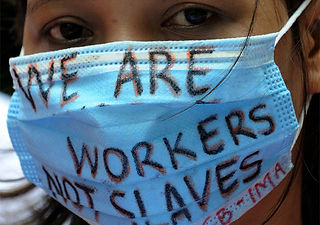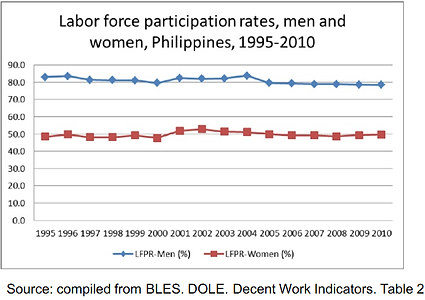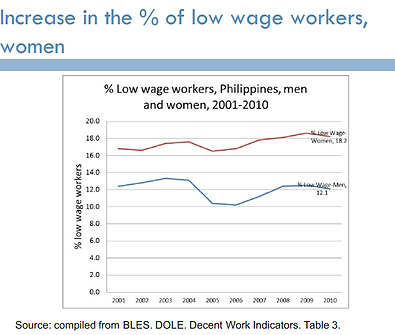
Gender Inequality and
Economic Growth
The Philippies
Basic Data
Population: 92.34 million
Life expectancy: 69.0
GNI per capita(Constant 2005 PPP): 3752
HDI index rank: 114
Source: UNDP (2013)


The Philippines is one of the world’s largest archipelago nations. It is located in Southeast Asia in the Western Pacific Ocean. There are wide disparities in income and quality of life across regions and sectors in the Philippines. The number of poor people remained high, with 26.5% of the total population lives below the poverty line, including 10 million women. Social inequalities are prevalence and impact indigenous people, fisher folk, women and the informal sector the most. (UNDP, 2013a)
In spite of widespread poverty, the Philippines has performed quite well in Human Development especially when in comparison with other Southeast Asian nations. It is classified as medium-HDI country and is ranked 114th out of 187 countries. In 2012, Philippines’ economy outpaced the growth of its neighboring countries with 6.6 percent growth rate. (UNDP, 2013a)
Gender Inequaity in The Philippines
Almost all the Philippines enjoy the widespread education brought by the United States after the Philippine-American War. And, in terms of edcuation and literacy, the Filipino females obtain even almost equal opportunity and level as males. Since 1990s, females consistenly get higher rates of cohort survival and completion rates than males in all levels of educatin. There has also been gender disparity which is infavor of females in terms of their participation rates in both secondary and tertiary education. (UNDP, 2013c)
In addition, in recent years, women have become more empowered through political and economic participation. Women are becoming more visible as leaders and thus more involved in policy decision making, both at the national and local levels. There are also more female workers who have been deployed abroad to work for the welfare of their families. However, more often than not, many filipino women tend to accept jobs that are usually not commensurate with their educational attainment such as domestic workers, caregivers, entertainers, clerical staffer or factory workers. (UNDP, 2013c)
While women have a large presence in the growing informal economy, they have limited benefits and protection, such as social security and health care. Moreover, their economic contribution was largely invisible. For instance, as a country with the highest number of Overseas Filipino Workers (OFWs) worldwide, women and men were almost equal in number. The national economy and a quarter of the country’s families were highly dependent on OFW remittances. However, the average cash remittances of women were only 60 percent that of men. This is indicative of the status of women OFWs in lesser skilled and often unprotected lower paying jobs. This renders women vulnerable to exploitation, trafficking and abuse. Of particular concern is that 72 percent of newly-hired OFWs in 2005 were women, indicating lack of opportunities locally for decent work and livelihood to provide for themselves and their families. (UNDP, 2013c)


The first women President in the Philippines

Overseas Filipino Workers in Hong Kong urging for better
legislative proctection for them
Gender Inequality in Women Economic Participation and Opportunity
According to The Global Gender Gap Report 2013, The Philippines has been ranked as 5 out of 136 countries in Gender Gap Index which indicate a quite well performance done by the Philippines in promoting gender equality. (Figure 1)

Figure 1: A graph of 2013 Gender Gap Index (GII) of the Philippines (World Economic Forum, 2013)
In the last decade had seen an increase in the number of women in the labor force with 50 percent of all women working compared to 80 percent of men. In terms of quality of work, 64 percent of those in higher wage-and-salary jobs and 67 percent of own-account workers were men. Among the employed women, 50 percent were wage-and-salary workers, 33 percent were own-account workers and 17 percent were unpaid family workers. (UNDP, 2013b)
Among the four gender gap sub-indexes, the Philippines has scored particularly high in educational attainment and health and survival sectors with 95.4 % of adult literacy rate. For the other two, progression had been made on political empowerment in the past few years. The Philippine Constitution upholds the right of women to sectoral participation in national and local legislative bodies. The Philippines is one of the few countries with a woman President. Four out of 24 senators are women. Women dominate the civil service at the technical level (74%), but are still largely outnumbered by men in decision-making positions (35%). For the ecnomic participation, the ranking contiunes to decline even though the score has been slightly increasing from 0.760 in 2009 to 0.777 at present, indicating the inequalities still remains in labor market and economic activities participation. World Economic Forum, 2013) (Figure 2)

Figure 2: A graph of four indicators of 2013 Gender Gap Index (GII) of the Philippines
(World Economic Forum, 2013)

Figure 3: A graph illustrate Gender Index Inequality(GII) (Human Development Report, 2013)
Although the Philippines has performed well in the health and empowerment sector in terms of gender equality, the Gender Inequality Index (Figure 3) of the Philippines scored only 0.418 according to the 2013 Human Development Report and ranked as 77 among 186 countries. This reveals the sector of labour market is not done well in the Philippines. The gender equality situation can be observed in legislation, professional and technical areas, with ranking above all other countries. However, its labour force participation is ranked as 101 and the estimated earned income is ranked as 68 only with female earns $2219 less than male even though the Philippines is ranked high in economic participation and opportunity. In other words, Filipino female participate much in the economic development and gain economic opportunity, but only small proportion of them are involved in larbour force and they earn much less than male. (UNDP, 2013b) (Figure 4)

Figure 4: A graph of Gender Gap Subindexes of the Philippines (World Economic Forum, 2013)
Actually, when only looking at the labour force participate rates within the countries, the rates of women is much lower than that of man. (Figure 5) What's more, the females in the Philippines have a low labour force participation rates when compared with females in other South East Asian countries like Vietnam. (Figure 6)

Figure 5

Figure 6



Women have higher education and functional literacy rates than men. However, the women’s rising education levels is not associated with the female labour force participation rate over the last decades owning to the market environment that favours the male within the countries. The share of agriculture in GDP is relatively low than other South Asian countries. The lack of land and concentrated land ownership pattern increased demand for male wage labour. Also the high total fertility rate, 3.0 births per woman, reduces the hours of paid work and earnings for women, but does not apply on men as the responsibility of nurturing the children are often beard by the women traditionally. 31% of working age women, compared with 2.9% of men, are economically inactive due to household and family duties. Moreover, there is lack of supporting infrastructure and gender equitable domestic and caring work roles in the Philippines. These all create constraints for women to participate in the labour market within the countries.
Although the average wage is increasing along the years for both men and women, wage employment is not equal to formal work. For women, only 65% of the wage employment in the non-agricultural sector is formal employment. What’s more, the industry jobs available for women are declining along the years and the % of low wage workers is much higher for women than men. In addition, the female-male daily wage ratio is 101.5 in 2010. They indicate that even women have been employed; they, on average, are paid less than men. There is wage discrimination against women. According to Van der Meulen Rodgers and Menon (2012), women experienced greater loss of wage and self-employment jobs and lager increases in unpaid family workers, compared to men. The estimated wage discrimination range from 23% to 30% (Figure 7, 8, 9)
Figure 9
Figure 7
Figure 8
Comparing with men, the market environment does not favour the female. And, to make a living for the families, many Filipino women choose unskilled jobs like domestic workers and personal service labour which do not match with their high education attainment. This results in the problem of Comparing with men, the market environment does not favour the female. And, to make a living for the families, many Filipino women choose unskilled jobs like domestic workers and personal service labour which do not match with their high education attainment. This results in the problem of brain drain of the country as well as deterioration of the gender disparity in terms of women participation and opportunity.
Economy
The Philippine economy has been regarded as resilient even though there is global food and fuel crisis. In the first quarter of 2012, the Philippine economy grew by 6.4%, the fastest since 2010 and already far outpacing the International Monetary Fund's forecast growth of 3.5% for that year. In addition, the Gross Domestic Product (GDP) of the countries increased by 1.40% in the 2nd quarter of 2013 over the previous quarter. (UNDP, 2013a; Vanessa, 2012) (Figure 10)

Figure 10: The Philippines’ Gross Domestic Product (GDP) per capita PPP from 2004 to 2012 (Trading Economics, 2013)
The Philippines is now at the status of emerging economy. In recent years, the country has been steadily growing mainly because of the inflow of foreign direct investment and remittances. Currently, the Philippines is the world’s largest center for business process outsourcing. The money sent home to the Philippines by its remittances serves as one the the important long-term stabilizers to make the Philippines being relatively unhindered by the sagging global economy. (UNDP, 2013a; Vanessa, 2012)
“About 70 % of our economy is from consumption, so remittance is the key fuel behind that, it drives consumption in malls. Even on the property side, the government estimates a third of remittances go into home purchases and rentals of properties,” said Haj Narvaez, Manila-based head of research for the Philippines at Credit-Suisse. (Vanessa, 2012)
It is estimated that 11% of the population of 92 million work overseas. Remittances account for about 10% of the country's GDP, which totaled $225 billion in 2011. (Vanessa, 2012)
However, this huge revenue from overseas workers is built on the fact that many women are working on the jobs that have a lower requirements on skills and educational levels like the domestic workers which do not match with their education attainment. And, the cash return on this sector constitutes nearly half of the cash obtained from the whole population of female remittances (Figure 11), indicating that the Philippines females are actually facing the gender disparity in market participation and opportunity outside their country. Even though the Gender Inequality Index (GII) increases along the years (Figure 12), it only refers to the advancement in other indicators of the GII like education and political participation. It cannot reflect the fact that even female have a higher economic participation within the country, they are actually facing gender inequality in terms of market participation outside the countries.

Figure 11: A graph showing the relatively higher cash obtained from female than male
remittances who are laborers and unskilled workers (Center for Women’s Resources, 2012)

Figure 12: The Philippines’ Gender Inequality Index (GII) from 2008 to 2012 (Human Development Report, 2013)
Relationship between Economy and Gender Inequality
The situation of gender inequality is likely to be one of the main factors impacting the economy growth of the Philippines. Larger labour force participation which in turns brings huge revenue back to the country and the economy is boosted with the influx of funds to the country. It is observed that the more female participate in the economic activities as labours, the more remittances returned from these workers to the countries, the higher GDP along the years. At the same time, the higher women participation and more remittances indicate the higher gender disparity they are facing and the worse of the gender inequality situation of the Philippines.
Reference
Center for Women’s Resources. (2012). Migrant Women’s Remittance. Retrieved November 25, 2013 from http://cwrawe.wordpress.com/2012/02/28/migrant-womens-remittance/
Human Development Report. (2013). The Rise of the South Human Progress in a Diverse World – Technical notes. Retrieved November 20, 2013 fromhttp://hdr.undp.org/en/media/HDR%202013%20technical%20notes%20EN.pdf
Trading Economics. (2013). Philippines GDP Growth Rate. Retrieved November 21, 2013 from
http://www.tradingeconomics.com/philippines/gdp-growth
Vanessa, K. (2012). CNN - What is driving the Philippines' surprisingly strong growth?. Retrieved November 19, 2013 from http://edition.cnn.com/2012/07/12/world/asia/philippines-surprise-surge/index.html
World Economic Forum. (2013). Insight Report – The Global Gender Gap Report. http://www3.weforum.org/docs/WEF_GenderGap_Report_2013.pdf
UNDP. (2013a). About the Philippines. Retrieved November 18,2013 from
http://www.undp.org/content/philippines/en/home/countryinfo/
UNDP. (2013b)Human Development Report - The Rise of the South Human Progress in a Diverse World. Retrieved November 19, 2013 from http://www.undp.org/content/dam/philippines/docs/HDR/HDR2013%20Report%20English.pdf
UNDP. (2013c). Promote Gender Equality and Empower Women. Retrieved November 17, 2013 from
http://www.undp.org/content/philippines/en/home/mdgoverview/overview/mdg3/
© 2023 by Dawkins & Dodger Architecture. Proudly created with Wix.com



